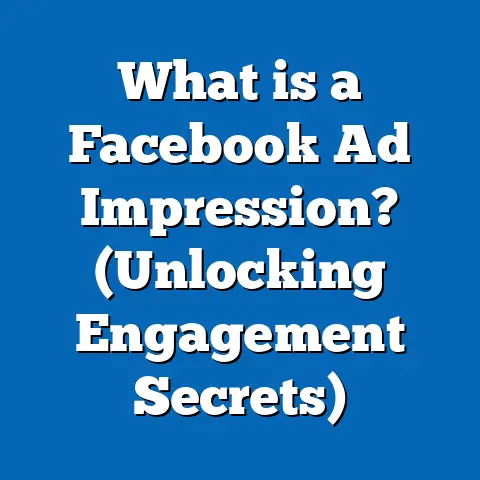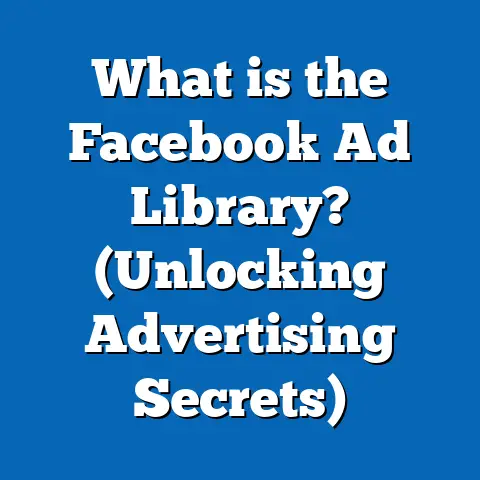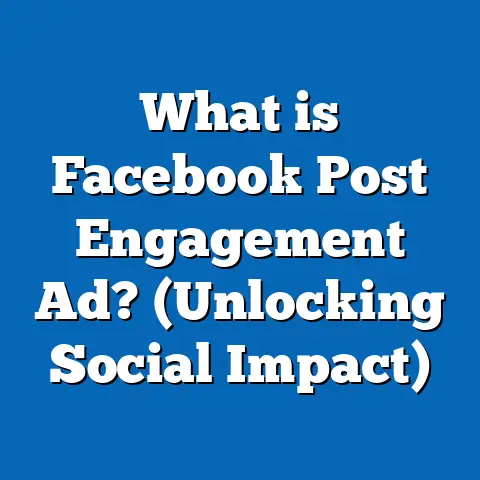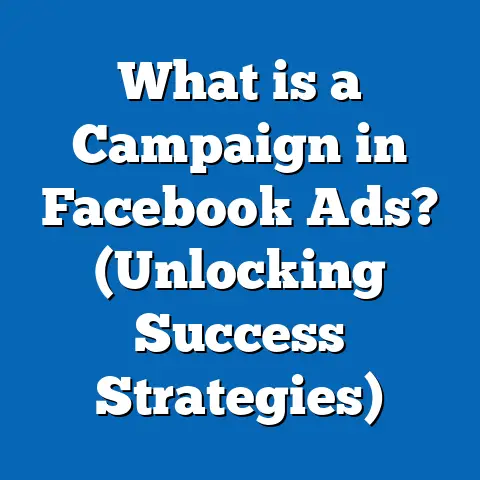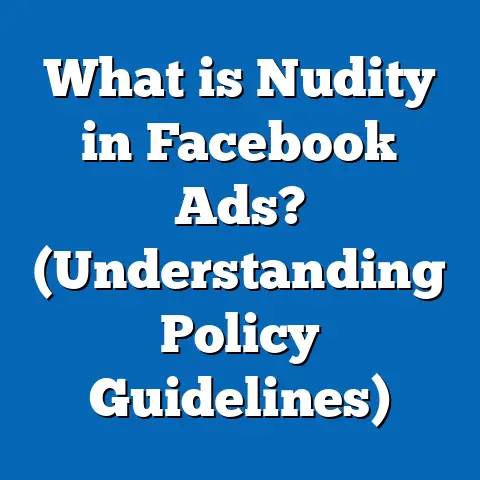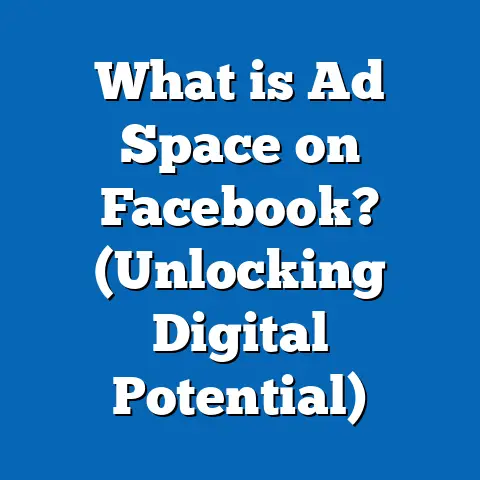What is Fake Facebook Ads About Celebrity Deaths? (Debunked!)
What is Fake Facebook Ads About Celebrity Deaths? (Debunked!)
Introduction: The Scale of Facebook Advertising and the Rise of Fake Ads
In 2024, Facebook continues to dominate the social media advertising space with over 2.9 billion active users worldwide and roughly 240 million users in the USA alone. Every day, businesses large and small invest billions of dollars into Facebook ads to reach their target audiences. Yet, alongside this phenomenal growth lies a significant problem: the proliferation of fake ads, especially those falsely reporting celebrity deaths.
Why does this matter? Because fake ads about celebrity deaths are not just harmless clickbait—they are a major source of misinformation that can damage brands, waste ad budgets, compromise user security, and disrupt trust in the digital ecosystem.
I’ve spent years working with businesses navigating the complex Facebook ad environment. I’ve seen firsthand how these fake death claim ads spread like wildfire, confusing users and causing reputational risks for legitimate advertisers. This guide pulls together the latest data, real-world examples, and hands-on tactics to help you understand, detect, and avoid these fake Facebook ads.
Current Landscape: Facebook Advertising in 2024
Facebook’s Reach and Ad Platform Overview
Facebook’s advertising platform offers unmatched targeting capabilities—age, gender, interests, behaviors, location, device usage—you name it. In the USA alone:
- 65% of adults rely on Facebook for news and updates.
- Over 10 million active advertisers compete daily for user attention.
- The average small-to-medium business (SMB) spends between $200 to $1,200 monthly on Facebook ads.
- Video ads now constitute over 35% of total ad spend, reflecting a shift toward engaging multimedia content.
However, with this vast reach comes increased scrutiny by users and regulators alike. Facebook’s algorithm prioritizes engagement, but this can be exploited by sensational or false content—including fake celebrity death ads—to generate clicks.
Why Celebrity Deaths?
Celebrity news naturally attracts massive attention. Whether it’s a beloved actor, musician, athlete, or political figure, people react strongly to news about deaths. This emotional response makes such topics prime targets for misinformation campaigns trying to exploit viral potential.
Defining Key Concepts: What Exactly Are Fake Facebook Ads About Celebrity Deaths?
What Constitutes a Fake Celebrity Death Ad?
Simply put: These are Facebook advertisements that falsely claim a celebrity has died or suffered a fatal event. They typically feature:
- Sensational Headlines like “Breaking News: [Celebrity Name] Dead at 42!”
- Manipulated Photos or Videos to provoke immediate emotional reactions.
- Misleading Links directing users to external websites with dubious or malicious content.
- Calls to Action encouraging users to “Share Now!” or “Click Here for Details.”
Types of Fake Celebrity Death Ads
- Direct Death Claims: Explicitly stating a celebrity has passed.
- Health Scare Ads: Suggesting a celebrity is critically ill or hospitalized.
- Memorial or Tribute Ads: Inviting donations or merchandise sales under false pretenses.
- Clickbait News Aggregation: Using unrelated or old content with misleading headlines.
My Personal Story: Encountering Fake Celebrity Death Ads Firsthand
When I first managed Facebook ads for a small business in California, I noticed an unusual trend. Competitors were running ads claiming that major celebrities had died overnight. These ads were getting huge engagement—likes, comments, shares—far exceeding what my carefully crafted campaigns achieved.
Curious (and alarmed), I dug deeper. I found that these ads:
- Often led to pages filled with third-party surveys asking for personal info.
- Had poorly edited images posing as “official” news.
- Were linked to scammy product offers or malware downloads.
I realized these weren’t just isolated incidents—they were part of a broader problem affecting advertisers and users across the USA. This experience drove me to learn how to identify and combat such fake ads effectively.
Data and Research on Fake Celebrity Death Ads
How Common Are These Ads?
- A 2023 study by the Center for Countering Digital Hate found that 12% of all misinformation on Facebook in the USA related to false celebrity death claims.
- Facebook reported removing over 1.5 million ads flagged as false information in 2023.
- Pew Research Center data shows 57% of Americans have encountered false celebrity death news on social media at least once.
The Impact of Such Ads
- Spread of false information undermines public trust.
- Users exposed to fake death news report heightened anxiety or confusion.
- Legitimate businesses associated with these ads risk damaging their brand reputation.
- Advertisers using such tactics can face account suspensions costing thousands in lost advertising spend.
How Fake Celebrity Death Ads Operate: A Technical Breakdown
Step 1: Emotional Triggering
These ads exploit natural human emotions—shock, sadness, curiosity. By triggering an immediate emotional response, users are more likely to click or share without verifying facts.
Step 2: Clickbait Headlines & Creative
Typical examples include:
- “You won’t believe what happened to [Celebrity] last night!”
- “Confirmed: [Celebrity] Dies Suddenly!”
These headlines often use uppercase letters, exclamation marks, and urgent language.
Step 3: Visual Manipulation
Photoshopped images or out-of-context videos add fake credibility. For instance:
- Using old photos but labeling them as recent.
- Editing images to appear like official news outlets.
Step 4: Redirection to Scammy Websites
Once clicked, users land on sites filled with:
- Surveys requesting personal info.
- Offers for fake products or services.
- Malware download prompts.
Step 5: Data Harvesting & Monetization
Some schemes use harvested data for identity theft or sell leads to third parties.
Step-by-Step Guide: How to Identify and Avoid Falling for Fake Celebrity Death Ads
Step 1: Check the Source
Is the ad linked to a credible news outlet or verified page?
- Always check if the page has a blue verification badge.
- Beware URLs that look suspicious (e.g., weird domains like “celebritynews123.com”).
Step 2: Verify With Trusted News Sources
Before believing or sharing:
- Search Google News for confirmation from outlets like CNN, ABC News, or Reuters.
- Use fact-checking websites such as Snopes or FactCheck.org.
Step 3: Analyze the Ad Creative Closely
Look for red flags:
- Poor image quality or obvious photo edits.
- Sensationalist language inconsistent with professional journalism.
- Multiple spelling or grammar mistakes.
Step 4: Review Comments & Feedback
Check user comments under the ad:
- Genuine news usually sparks balanced discussions.
- Bots often leave repetitive comments or spam.
Step 5: Report Suspicious Ads to Facebook
Use Facebook’s “Report Ad” function:
- Click the three dots on the ad.
- Select “Report Ad.”
- Choose “False Information” or “Scam” as reasons.
- Submit to help Facebook review and take action.
Technical Specifications & Limitations of Facebook Ads to Watch For
Knowing Facebook’s ad specs helps you differentiate legitimate ads from fakes.
| Ad Type | Specs & Limits | How Fakes Exploit Them |
|---|---|---|
| Image Ads | Max file size: 30MB; Recommended size: 1200×628 px | Use manipulated images with misleading text |
| Video Ads | Max length: 240 minutes; Recommended ratio: 16:9 | Edited clips with sensational captions |
| Carousel Ads | Up to 10 cards; each image max 30MB | Multiple fake headlines in one ad |
| Instant Experience | Full-screen mobile ads; fast loading | Overload users with bite-sized false news stories |
Best Practices for Small and Medium Businesses (SMBs) in the USA
Avoiding Association With Fake Celebrity Death Ads
- Work Only with Trusted Agencies: Always vet your marketing partners thoroughly.
- Use Verified Facebook Pages: Promote your business through pages with blue checkmarks.
- Regularly Monitor Your Ads: Use Facebook’s Ads Manager reports to spot anomalies quickly.
- Train Your Marketing Team: Make sure everyone knows how to spot suspicious content.
- Leverage Brand Safety Tools: Use Facebook’s Brand Safety Control features and Audience Network filters.
Real-Life Case Study: How an Austin Boutique Navigated Fake Death Ads
A boutique clothing store in Austin faced indirect challenges from competitors running fake death claim ads about a popular country singer. These competitors linked users to their shops under the guise of memorial sales.
The boutique owner:
- Monitored competitor activity daily.
- Verified all news claims before responding publicly.
- Reported fake ads promptly via Facebook’s tools.
- Communicated openly with their customers about misinformation.
Result? They maintained brand integrity and even attracted new customers who appreciated their transparency.
Budgeting & ROI Concerns When Dealing With Fake Ads
Fake celebrity death ads might seem cheap or effective due to high engagement but come with hidden costs:
Wasted Budget on Low-Quality Traffic
Bots or uninterested users clicking on these ads don’t convert into paying customers.
Risk of Account Suspension
Facebook aggressively penalizes misleading advertising:
- Suspended accounts lose all active campaigns.
- Reinstatement can take weeks or months.
Damage Control Costs
Brands must invest time and money repairing reputations harmed by association with fake ads.
Maximizing ROI Safely on Facebook Ads
To ensure your ad spend works hard for you:
- Craft Clear & Honest Messaging: Avoid sensationalism; build trust instead.
- Target Precisely: Use Facebook’s detailed targeting tools based on verified interests.
- Audit Campaigns Regularly: Spot suspicious spikes in traffic or engagement early.
- Invest in Quality Creative: Use professional images/videos that reflect your brand values.
- Test & Learn: Run A/B tests and iterate based on data-driven insights.
Troubleshooting Common Issues Linked to Fake Celebrity Death Ads
| Problem | Cause | Practical Solution |
|---|---|---|
| Sudden Drop in Ad Performance | Facebook penalizes misleading content | Review all creatives; remove questionable ads |
| Account Flagged or Disabled | Violation of advertising policies | Appeal promptly; audit all campaigns |
| Negative User Comments | Users spotting misinformation | Respond transparently; provide accurate info |
| Increased Spam Interactions | Bots engaging with ad | Tighten audience targeting; use spam filters |
Additional Tools & Resources for Staying Safe on Facebook Ads
- Facebook Business Help Center: For policy updates and troubleshooting (link).
- Snopes & FactCheck.org: Reliable fact-checking websites for verifying celebrity news.
- Google Alerts: Set alerts for major celebrity news to cross-check claims quickly.
- Brandwatch / Hootsuite: Social listening tools that help monitor brand mentions linked to misinformation.
- Local Marketing Groups: Join USA-based SMB forums focused on ethical digital marketing practices.
Next Steps for Advertisers Concerned About Fake Celebrity Death Ads
- Audit your current ad campaigns for any suspicious content or engagement spikes.
- Educate your team about recognizing false ads and reporting mechanisms.
- Create a crisis communication plan if your brand is associated accidentally with misinformation.
- Regularly update your audience with authentic content reinforcing your brand values.
- Stay connected with Facebook’s policy changes and industry best practices through trusted channels.
Conclusion
Facebook remains an incredibly powerful platform for marketers aiming to grow their business across the USA. But with great opportunity comes responsibility—to be vigilant against fake ads exploiting sensitive topics like celebrity deaths.
By understanding how these fake ads operate, learning how to spot them early, and implementing best practices for safe advertising, you can protect your brand reputation while maximizing your return on investment.
Remember my own journey—what started as confusion turned into knowledge that helped me safeguard my clients’ campaigns from falling into dangerous traps. You too can master this landscape by staying informed and proactive today!
Stay sharp out there—and keep your advertising honest and trustworthy!

